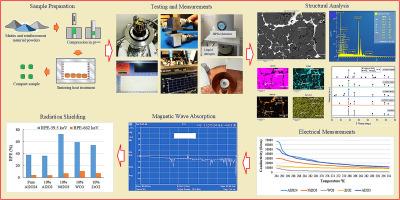多氧化物陶瓷增强Al2024复合材料的结构、磁性、电学和屏蔽性能
IF 5.7
3区 材料科学
Q2 MATERIALS SCIENCE, MULTIDISCIPLINARY
引用次数: 0
摘要
在本研究中,研究了在市售Al2024合金中加入不同的陶瓷氧化物所获得的结构的电、磁、辐射和结构性能。结果表明,在铝中加入氧化陶瓷颗粒对复合材料的结构性能有影响。XRD分析表明,Al2024基体中成功加入了二次相,未形成金属间颗粒。当对样品的电磁波吸收进行检测时,发现zro2掺杂样品的电磁波吸收效果最好。在电导率测量中,al2o3掺杂样品的电阻率值最低。观察到辐射屏蔽性能的变化取决于光子的能量和掺杂陶瓷氧化物的类型。根据能谱仪测得的辐射屏蔽值,掺nd2o3样品的辐射屏蔽性能最好。本文章由计算机程序翻译,如有差异,请以英文原文为准。

Structural, magnetic, electrical and shielding behaviors of multi-oxide ceramic reinforced Al2024 composites
In this study, the electrical, magnetic, radiation, and structural properties of structures obtained by adding different ceramicoxides to the commercially available Al2024 alloy were investigated. It was observed that the ceramicoxide particles added to the aluminum affected the structural properties of the composite. XRD analysis showed that secondary phases were successfully incorporated into the Al2024 matrix without the formation of intermetallic particles. When the electromagnetic wave absorptions of the samples were examined, it was observed that the best absorption was in the ZrO2-doped sample. In electrical conductivity measurements, the lowest electrical resistivity value was observed in the Al2O3-doped sample. It was observed that radiation shielding performance varies depending on both the energy of the gamma photon and the type of doped ceramic oxide. According to the radiation shielding values determined by the gamma spectrometer with an HPGe detector, the best radiation shielding property was obtained from the Nd2O3-doped sample.
求助全文
通过发布文献求助,成功后即可免费获取论文全文。
去求助
来源期刊

Materials Research Bulletin
工程技术-材料科学:综合
CiteScore
9.80
自引率
5.60%
发文量
372
审稿时长
42 days
期刊介绍:
Materials Research Bulletin is an international journal reporting high-impact research on processing-structure-property relationships in functional materials and nanomaterials with interesting electronic, magnetic, optical, thermal, mechanical or catalytic properties. Papers purely on thermodynamics or theoretical calculations (e.g., density functional theory) do not fall within the scope of the journal unless they also demonstrate a clear link to physical properties. Topics covered include functional materials (e.g., dielectrics, pyroelectrics, piezoelectrics, ferroelectrics, relaxors, thermoelectrics, etc.); electrochemistry and solid-state ionics (e.g., photovoltaics, batteries, sensors, and fuel cells); nanomaterials, graphene, and nanocomposites; luminescence and photocatalysis; crystal-structure and defect-structure analysis; novel electronics; non-crystalline solids; flexible electronics; protein-material interactions; and polymeric ion-exchange membranes.
 求助内容:
求助内容: 应助结果提醒方式:
应助结果提醒方式:


